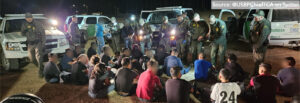By Ana Goerdt, Program Officer
Please click here to visit the Border Fact Check Blog
“…There’s also another resource that’s coming back from Iraq and Afghanistan, and that’s our men and women in uniform, specifically our members of the National Guard. There’s already been reports of them being engaged working along the border in several areas… the ‘surge’ concept is exactly what we were thinking—it was successful in Iraq, Afghanistan, apparently it’s been successful on the border.”
-Rep. Steven Palazzo (R-Mississippi), July 23, 2013
During a recent hearing on border security, Rep. Palazzo of Mississippi floated the idea of deploying members of the National Guard to secure the border. But have these types of “surges” along the border been successful?
The facts:
While it’s true that National Guard troops have been sent to the U.S.-Mexico border to assist Customs and Border Protection personnel, experience tells us that such deployments are an inefficient use of resources.
From 2006 to 2008, the Bush administration deployed 6,000 National Guard troops to the border in Operation Jump Start. In 2010, 1,200 National Guardsmen were deployed to the border under the auspices of Operation Phalanx. It’s important to note that Operation Jump Start and Operation Phalanx were not meant to be border security game-changers. Rather, both were considered stopgap measures to provide temporary personnel “bridges” until the Border Patrol could complete the training of thousands of new agents.
In fact, Guardsmen along the border were (and continue to be) limited in their duties: by order of the Department of Defense, they are not allowed to be involved in the direct detention, search, or arrest of individuals. A September 2011 report by the Government Accountability Office voiced concern over citizens’ perceptions of increased border militarization; the fact that temporary National Guard deployments make it difficult to formulate a long-term border security strategy; and the cost effectiveness of the deployments. The Washington Post noted that as of December 2011,
“The 1,200 National Guard troops have helped Border Patrol agents apprehend 25,514 illegal immigrants at a cost of $160 million — or $6,271 for each person caught… [T]he National Guard is credited with helping law enforcement seize 83,629 pounds of marijuana in the past 16 months. That is about 2.6 percent of the tons of pot seized each year along the southwestern border.”
As criticism of Operation Phalanx mounted and budget pressures increased, in March 2012 the Obama administration reduced the number of National Guard troops on the border from 1,200 to 300. Under Operation Nimbus, the remaining troops’ mission shifted from ground surveillance to aerial surveillance – “boots in the sky” instead of “boots on the ground.”
While talk of “surges” may play well to certain political audiences, the high price tags and relative lack of results of Operations Jump Start and Phalanx make it clear that the National Guard is not a silver bullet for border security.
WOLA’s Border Fact Check debunks false or misleading claims to inform you about what is really happening on the U.S.-Mexico border. To read the latest from our experts, visit www.borderfactcheck.com.

